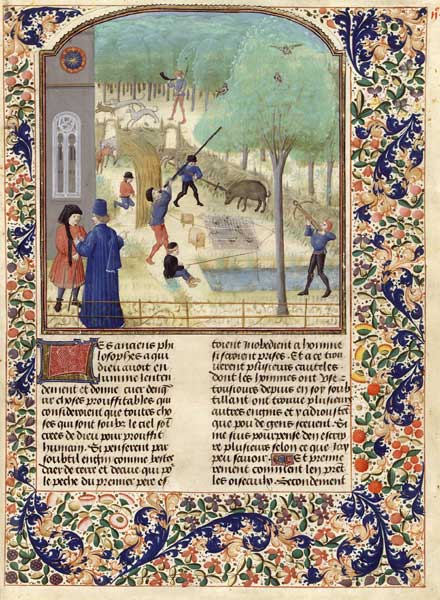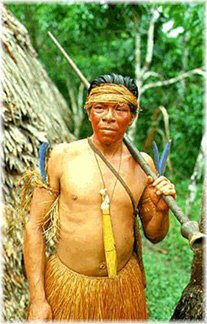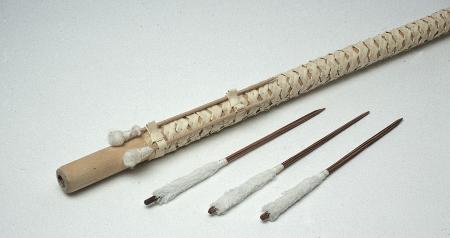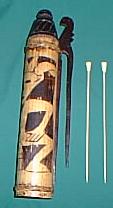James Stuart Koch

Pier de Crescenzi, Livre des prouffitz champestres et ruraulx
Flandre (Bruges), 3rd quart 15th Century
Maitre de Margueritte d'York et atelier
Parchment 42.5 x 32 cm
BnF, Arsenal, Manuscript 5064, fol.265
|
Contents The Origin Of The Blowgun Primitive Blowguns Traditional Blowguns Bored Blowguns Mouthpieces & Muzzles Sights & Shooting Marks Bore Size & Length Variations Of Form Projectiles Uses Quivers Ram Rods Decoration References The origin of the blowgun, in terms of time and place, is lost in pre-history. Many scholars believe that, due to it's simplicity, this weapon was invented and re-invented in various locations. Most agree though that the blowgun dates back to the stone age and was known and used at that time on all the inhabited continents, with the exception of Africa. Despite its worldwide distribution, the average weapon varies little in form across its entire geographic range, and has changed little over time. This consistency of form has led archaeologists to postulate that prehistoric contact existed between tropical peoples around the globe. The earliest examples were likely toys which eventually evolved into true hunting weapons for taking birds and small mammals. In areas where blowguns were used for hunting, children were often given toy versions and adolescents scaled down training weapons. (1) The earliest type, and the one which is the most widely distributed worldwide, is what I refer to as a primitive blowgun. (2) These consist of a bamboo, cane, or similar natural tube of plant origin. Bamboo is an obvious choice when making a blowgun since its stems are largely hollow and relatively straight. Slight kinks are reduced by heating the cut pole over a small fire while applying bending force. (3) The stems of bamboo are divided into nodes by septums, the walls of which are a fraction of an inch thick. Blowgun makers devised a number of solutions to deal with the problem of the septums. Some species of bamboo have nodes which are up to four feet long, but only a few are of the correct diameter for use as a blowgun. Where long nodes of the right diameter were available, two or more nodes were cut to remove the septums and then splinted and lashed together end to end. In some cases tubes of larger diameter were used to splice the smaller tubes. In other cases a larger diameter bamboo tube was split and its septum walls removed. The smaller tubes were then placed inside the larger tube, which was glued and lashed back together. Where bamboo with shorter nodes was the only type available, one solution was to split the tube end to end and remove all of the septum walls. The resulting halves were then glued and lashed back together with cord or ratan. In East Pakistan sections of the tube wall were carefully cut away at the septums. The septums were then removed and the tube wall sections glued back into place with wax. (2) The most common solution was to burn, punch, or drill out the septums using a smaller diameter wood or bamboo rod. The septums were burned by repeatedly dropping small hot coals into the tube. Once the septum had been burned through, a long shaft tipped with an arrowhead was used to ream away what remained. Where bamboo and similar natural tubes were unavailable, other woody plant parts such as palm stems or elder were utilized. These contain a soft pith which may be pushed, burned, or bored out. Alternatively the material may be split and hollowed and lashed back together as with bamboo. The resulting tube was polished using a smaller diameter bamboo or wooden rod and sand. Bamboo blowguns were found in North, Central, and South America, Europe, Asia, and across the Pacific. Split Palm stem traditional blowguns were introduced to Madagascar from Malaysia in the early Christian era. The earliest written references to blowguns are from Rome in the 2nd century AD and from Chin dynasty China between 265 and 429 AD. In Rome it was mentioned by the imperial architect, Appollodorus Of Damascus in his book the Poliorcetus, a work written in Greek on the subject of siegecraft. (13) Appollodorus states: "And if not, reeds, too, are put together, such as bird-catchers use after they have bored holes all the way through them". In Peru illustrations of blowguns have been found which date back to the 6th century AD. The earliest illustration of a blowgun from Europe, of which I am aware, is a French illuminated manuscript of the early 14th century depicting a naked youth shooting a rabbit. (4) The weapon in this depiction is at least one and a half times the length of the boy's body indicating that it is not a simple pea shooter. A later type of blowgun which I refer to as the traditional design was made by splitting or sawing a length of wood and gouging a half round lengthwise groove in both pieces. (1) This is similar to splitting a length of bamboo to chisel out the septum walls, only more material must be removed. Afterwards the two lengths are glued back together, smoothed, and wrapped as with the earlier bamboo blowguns. Various materials have been used for wrapping, such as cord, ratan, bark, cloth, paper, or leather. Some such blowguns were covered in metal sheeting including silver and gold. Paper cloth and similar materials were often coated with gum, wax, lacquer, or similar waterproofing. Once assembled the bores were reamed smooth as with the bamboo weapons. Wooden blowguns of this type take longer to make but have several advantages. They can be made when and where appropriate bamboo is unavailable and their barrels are very straight and smooth. These can shoot much more precisely made and tighter fitting projectiles with less drag. Traditional blowguns and the iron rod drilled variety are believed to have been introduced to Northern Africa and Europe circa 1250AD by seafaring Arab traders. The Mamelukes of Egypt referred to the weapon by its Arabic name "zabatana". This is derived from the Malay name "sumpitan" These are documented in Flanders by the fourteenth century where they were called a sarbacane. (2) By this time the traditional blowgun was known across Southern Europe from whence it diffused North as far as Scandinavia. The Southern European names for the Arab supplied traditional type blowgun are as follows: sarbatana, zar[a]batana, zerbatana, sarabata, sarbacana, esgaravatana, esgarapatana (Portuguese); cerbatana, zerbatana (Spanish and Catalan); sarbacano, serpatano, sarpatano, soumpetano (Provencal); cerbottana (Italian). Germanic languages used descriptive terms such as blasrohr, literally "blow" "tube". (8) A third method of making a blowgun was invented by the Dyaks of Borneo. (5) These were made by cutting one long piece of wood. A platform was attached to the side of a tree as high as the blowgun would be long. The length of wood was then lashed vertically to the edge of the platform. The maker drilled down into the end of the wood with a long iron rod tipped with a triangular steel point. This was done by lifting, droppimg and turning the rod, which was kept in proper alignment by forked guides. An assistant ladled water into the hole from time to time to float out the chips. Once the length of the bore had been drilled the tube was planed to the proper diameter and the bore smoothed. This type of blowgun needed no gluing or wrapping, but required specialized tools and a great deal of skill on the part of the maker. The resulting tube was also strong enough to serve as a spear shaft and many surviving examples are equipped with an offset iron lance head similar to a bayonet. This method of chiseling the bore did not spread beyond Borneo. However, eventually augurs were introduced and drilled blowguns were also made in Penang, Malaya, and South India. Bored blowguns became an item of export and were found far from their point of manufacture. 
Yagua Hunter Of The Amazon Many blowguns were equipped with mouthpieces, which might be funnel, hour glass, hemispherical, or cylindrical in terms of the outside shape. The purpose of the mouthpiece was to get a tighter seal so that the shooter could exert greater air pressure and hence obtain a higher dart velocity. Some were actually shaped so as to fit in the shooter's mouth. On most examples, the breech end consisted of a wooden funnel, like the mouthpiece of an oversized trumpet, against which the shooter's lips could be pressed. The funnel shape also facilitated loading when multiple dart hits were required to bring down larger game. The muzzle ends of blowguns were sometimes protected by a ring of tough material. In Guiana the shell of an acquero nut was used. In the old world, rings of horn, coconut shell, and metal were common. Some blowgun tubes have slight natural curves and others were curved or left curved intentionally. It was then possible to hold the tube so that when the correct side was up, the weight of the muzzle end would cause the bore to straighten. A marker such as two nearly identical teeth of an animal would be lashed to the sides of the tube, three to four feet from the mouthpiece. These indicated which side was to be at the top and also served as a simple sight. Two were required since when shooting a blowgun, both of the shooter's eyes are left open. With standard primitive and traditional blowguns it is not possible for the shooter to align an eye with the barrel while blowing into the breech. Instead while focusing on a distant object the shooter sees the illusion of two side by side muzzles in his field of vision, one slightly to the left and the other slightly to the right of the target. Two nearly identical markers lashed to the sides of the barrel and in a ways from the muzzle form an image perfectly bracketing the target. By moving the sight along the barrel it is possible to adjust for various ranges. In addition to teeth, wax, wood, bamboo, seeds, beads, and jewels were attached anywhere between the muzzle and the mouthpiece, depending how the weapon was to be used. Blowguns varied in terms of caliber and length. Although some earlier Japanese blowguns were over nine feet long, most were the length of a walking staff of five to six feet. Ninja assassins supposedly carried short concealable weapons. The bore of the Japanese weapon was of very small size, as low as one quarter inch = 25 caliber. (6) The tiniest ninja blowgun was a fukibari which was made from a bamboo tube small enough to be concealed in the users mouth. It contained a bundle of un-poisoned needles which could be blown in an opponents face during a fight. A survey of Cherokee river cane blowguns revealed an average bore of 19/32 inch = 61 caliber. This is likely determined to a great extent by the fact that a length of cane or bamboo stiff enough to make an 8 to 10 foot blowgun will naturally have a bore of around that size. The bamboo blowguns I have made varied from 56 to 68 caliber. Most hunting blowguns were from five feet to twenty three feet long. I assume the twenty three foot variety would have been used exclusively for shooting nearly vertically into trees with the muzzle end braced against a limb or branch. I have shot seven foot long blowguns without difficulty, but imagine that one three times as long, and stiff enough to be held from one end without excessive muzzle sag, would be very heavy. Supposedly blowguns averaged nearer the eight to nine foot length. Most of those I have seen depicted or in collections appeared to be about that length. A number of variations have been made on the theme. An expedient blowgun was made in the field by some Pacific islanders. This consisted simply of several large leaves rolled and bound together to form a tube. (2) Blowguns have been found in the Celebs with two and three inner tubes, allowing multiple projectiles to be shot with one breath. In other places two or more tubes were lashed together side by side so that they could be shot separately. The Choctaws of the Southeastern US supposedly lashed together four or five tubes in a pan pipe arrangement. (9) This would have been useful in situations where multiple shots were required to bring down game from a tree. Even with poisoned darts, several good hits were usually required before the game was incapacitated or killed. In India barbed darts attached to lines were devised for shooting fish. Later Japanese blowguns were usually made of bamboo with an offset mouthpiece allowing the shooter to aim along the barrel as with a gun. The dart was loaded into the bore and a plug was affixed behind it to close the breech. Metal blowguns were also manufactured. In India, blowguns were sometimes made of brass. Iron tube blowguns were manufactured during the renaissance in Europe. An example of one of these can be found in the Museum in St Ettienne, France. The largest blowguns ever made were the Greek fire shooting iron tubes used in the Eastern Roman Empire in late classical times. These were actually blowgun cannons and were the precursors of the airguns of the 16th and later centuries. (7) How the Greek Fire was propelled is largely a matter of conjecture. It may have been forced by heated air or steam or simply pumped by some mechanical device. 
Houma Rabbit Fur Piston Darts From US Two main types of projectiles were shot from blowguns. The simplest and likely the earliest were pellets. Not much later darts were introduced. Primitive pellets could be made of stone or clay. When firearms became available, lead balls identical to gun shot were also occasionally used. The remains of darts and pellets are often found together in various proportions by archaeologists. Pellets seem to be the projectile of choice for birds and the smallest game. Darts could be made much larger and were sometimes poisoned. Various materials such as bamboo, wood, and even bone were used to fabricate the shafts of darts. These varied in length from an inch up to thirty six inches on Timor and New Britain. (5)&(2) Blowgun darts were sometimes simply sharpened and fire hardened, or tipped with pirahna teeth, stone, or metal points. Since the dart shafts were of a smaller diameter than the bore of the blowguns from which they were shot, a piston was required to drive them down the barrel. Pistons varied in type from region to region and were generally glued or tied to the back end of the dart. In South America darts were driven by kapok, or monkey fur. In North America milkweed cotton or rabbit fur were used. In Asia and the Pacific, darts were driven by cork, pith or cones made of rolled and glued materials. Feather fletching was widely distributed, but limited to the old world. Twisted helical darts were also produced by the Houma, Choctaw, and Creek people of the Southern US. (9) The twisting caused such darts to rotate in flight and prevented planing, thus greatly improving the accuracy of the projectile. These were made by splitting cane and twisting the resulting square shafts while heating them over a fire. Where pellets and darts with pistons made of hard material were fabricated, gauges were used. These were made of shell, bone, or bamboo. When making my own darts I resort to using a plastic circle drawing template for rough checking the pistons. I find though that nothing beats running the dart through the bore of the actual weapon prior to taking it to the field. Poisons were identical to those used locally on arrows. In South America curare and poison dart frog poisons were the two most common. In Asia and the Pacific, numerous local poisons were used, most of which contained ipoh as an ingredient. The Japanese Ninja supposedly placed a paste of fugu fish poison on their darts. The shafts of poisoned darts were often notched a short distance back from the point. This caused the point to break off and remain in the wound, increasing the chance that sufficient poison would be absorbed by the target animal. One other type of projectile was used and this, as far as I have been able to determine, was confined to Japan. This was a blowgun containing blinding powder. The most common type of powder was a fine pepper dust which could be blown or flung into an enemies eyes, exactly like modern day mace. This was a weapon used primarily by members of a town watch to subdue unruly drunks and the like when a non-lethal weapon was required. Blinding powder was originally shot from staff type blowguns, and later from small boxes with a mouthpiece and a barrel known as a metsubushi or gantsubushi. (5) Although blowgun darts are much lighter than arrows and pack less energy, they are extremely fast and accurate. Blowgun darts can travel at speeds of over 400 feet per second. (11) This is roughly twice the velocity of an arrow from a wooden self bow. Blowguns are therefore ideal for hunting small game at short ranges. They are also surprisingly fast and silent, often allowing a hunter to get off a second shot if the first missed. The relatively easy to make darts and even easier to mass produce pellets allow a hunter to shoot birds and monkeys in trees. Shooting into a tree using a bow can be expensive, since a miss can cause the loss of an arrow, or at least require a difficult and dangerous recovery. In densely forested parts of Southeast Asia blowguns actually completely replaced bows over time. The hand held common variety of blowgun was rarely used in warfare. Even the people who hunted regularly with poisoned darts set aside their blowguns in favor of swords during times of war. The exception was renaissance Italy. 
Bamboo Dart Quiver With Belt Hook From Borneo Darts were carried in quivers. In the old world these were most often made of a length of bamboo with a removable cover. Some had a strip of wood or bamboo attached to the back to form a long hook which allowed the quiver to be slipped over a wide cloth belt. Others had cords which could be tied around the waist. Some had multiple inner tubes, each one just large enough to hold a single dart. In the new world, quivers were often woven from palm fronds, attached to a cord and slung around the neck or over a shoulder. The darts they contained consisted simply of a sharpened poisoned shaft with no piston, just a bit of sticky tree sap on the butt end. A hollow nut was also carried which contained kapok. When a target was sighted, the hunter would grab a dart and a pull a tuft of Kapok from the nut. This he would quickly roll onto the butt end of the dart where it adhered due to the tree sap. In its South American cultures wing, The American Museum Of Natural History shows an excellent continuous loop video of Warani Indians hunting a howler monkey with a blowgun using exactly this sort of dart. They also have an example of the palm leaf quiver and kapok filled nut on display as part of their permanent collection. In most places pellets were carried in leather, or woven bags attached to a belt. As I have learned through personal experience, an essential accessory to the blowgun is the ramrod. A slightly too large dart or pellet may become stuck in the bore and the ramrod is required to remove it. I once went out target shooting and had two blowguns each with a stuck dart! Ramrods are needed even with the traditional weapon having a relatively smooth bore. A projectile becoming stuck can occur due to the bore not being perfectly round or to swelling of the missile and/or tube due to changes in humidity. Stone describes ramrods with perforations near one end through which leaves can be strung for cleaning the bore. I have seen an example of a ram rod made of palm wood in the collection of the American Museum Of Natural History in New York City. It is associated with a five and one half foot long childs blowgun from Indonesia. (1) Blowguns and especially their accessories were often decorated. Many quivers show carved and stained geometric and zoomorphic designs as do the nuts used in South America to hold the kapok for the darts. Monkeys were a commom motif on bamboo quivers from Borneo. Amazonian blowguns were sometimes decorated with feather work, which is not surprising since feather decoration is so common in those cultures. I have seen depictions of blowguns carved in the shape of dragons with the mouth of the beast at the muzzle. These though were quite modern, small, and obviously made for the tourist trade. Miniature modern blowguns are sold in both the old and new worlds. (12) The examples of older weapons I have seen in the museums were all relatively unadorned. The main decoration on the barrels of actual hunting weapons consisted mostly of the bark, ratan, or basket weave overwrap added to prevent splitting. (1) the permanent collection of the American Museum Of Natural History in New York City. (2) The Developement And Distribution Of The Blowgun by Stephen Jett, Annals of the Association of American Geographers, 1970 vol. 60(4): 662 – 688 (3) This is still practiced by the Cherokee (4) French book of hours circa 1330 in the collection of the British Library "MS. 36684, fol.44" (5) A Glossary Of The Construction, Decoration And Use Of Arms And Armor by George Cameron Stone (6) Secrets Of The Samurai by Oscar Ratti & Adele Westbrook (7) Le Feu Gregeois, les Feux de Guerre, Paris : Orientale 1952 by M. Mercier (8) The Journal Of The Royal Anthropological Institute Of Great Britain And Ireland, Vol 54 1924 pp 316 to 346 (9) Further Information On The Geography Of The Blowgun ... by Stephen Jett, Annals of the association of American Geographers, 1991 vol. 81(1): 89 – 102 (10) A survey of Cherokee river cane blowguns (11) Spurlock Museum Collection (12) Decorated miniature Amazonian blowguns manufactured for the tourist trade (13) La Poliorcetique de Appolodore de Damas" by E Lacoste in the Revue des Etudes Greques, Vol 3 (1890), p 268. translated by Ursula Whitcher |